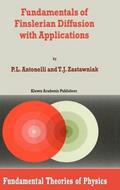L’articolo è stato aggiunto alla lista dei desideri
IBS.it, l'altro eCommerce
Fundamentals of Finslerian Diffusion with Applications
Cliccando su “Conferma” dichiari che il contenuto da te inserito è conforme alle Condizioni Generali d’Uso del Sito ed alle Linee Guida sui Contenuti Vietati. Puoi rileggere e modificare e successivamente confermare il tuo contenuto. Tra poche ore lo troverai online (in caso contrario verifica la conformità del contenuto alle policy del Sito).
Grazie per la tua recensione!
Tra poche ore la vedrai online (in caso contrario verifica la conformità del testo alle nostre linee guida). Dopo la pubblicazione per te +4 punti
- Consegna a domicilio Gratis
- Consegna Standard in negozio Gratis
Altre offerte vendute e spedite dai nostri venditori



Tutti i formati ed edizioni
Promo attive (0)
The erratic motion of pollen grains and other tiny particles suspended in liquid is known as Brownian motion, after its discoverer, Robert Brown, a botanist who worked in 1828, in London. He turned over the problem of why this motion occurred to physicists who were investigating kinetic theory and thermodynamics; at a time when the existence of molecules had yet to be established. In 1900, Henri Poincare lectured on this topic to the 1900 International Congress of Physicists, in Paris [Wic95]. At this time, Louis Bachelier, a thesis student of Poincare, made a monumental breakthrough with his Theory of Stock Market Fluctuations, which is still studied today, [Co064]. Norbert Wiener (1923), who was first to formulate a rigorous concept of the Brownian path, is most often cited by mathematicians as the father of the subject, while physicists will cite A. Einstein (1905) and M. Smoluchowski. Both considered Markov diffusions and realized that Brownian behaviour nd could be formulated in terms of parabolic 2 order linear p. d. e. 'so Further more, from this perspective, the covariance of changes in position could be allowed to depend on the position itself, according to the invariant form of the diffusion introduced by Kolmogorov in 1937, [KoI37]. Thus, any time homogeneous Markov diffusion could be written in terms of the Laplacian, intrinsically given by the symbol (covariance) of the p. d. e. , plus a drift vec tor. The theory was further advanced in 1949, when K.
L'articolo è stato aggiunto al carrello
Le schede prodotto sono aggiornate in conformità al Regolamento UE 988/2023. Laddove ci fossero taluni dati non disponibili per ragioni indipendenti da IBS, vi informiamo che stiamo compiendo ogni ragionevole sforzo per inserirli. Vi invitiamo a controllare periodicamente il sito www.ibs.it per eventuali novità e aggiornamenti.
Per le vendite di prodotti da terze parti, ciascun venditore si assume la piena e diretta responsabilità per la commercializzazione del prodotto e per la sua conformità al Regolamento UE 988/2023, nonché alle normative nazionali ed europee vigenti.
Per informazioni sulla sicurezza dei prodotti, contattare complianceDSA@feltrinelli.it
L’articolo è stato aggiunto alla lista dei desideri

